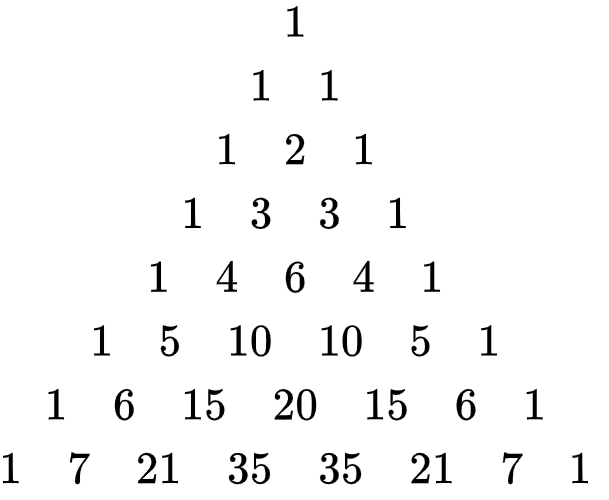1.2.4: Powers of Monomials and Binomials
- Page ID
- 130850
By the end of this section, you will be able to:
- Expand a positive integer power of monomial and binomial expressions
- Identify coefficients of terms of a positive integer powers of a binomial expression
Before we get started, take this readiness quiz.
1. Expand \((2x-3)^2 \).
2. Simplify \((3\cdot 5\).
3. Evaluate \((5x^3\) at \(x=2\).
Powers of Monomials
Now let’s look at an exponential expression that contains a power raised to a power. Let's see if we can discover a general property.
| \(\quad (x^2)^3\) | |
|---|---|
| What does this mean? | \(=x^2x^2x^2\) |
| How many factors altogether? |
\(=\underbrace{x\cdot x}_{2\; factors }\cdot \underbrace{x\cdot x}_{2\text{ factors }}\cdot \underbrace{x\cdot x}_{2\text{ factors }}\) \(=\underbrace{x\cdot x\cdot x\cdot x \cdot x\cdot x}_{6\text{ factors }}\) |
| So we have | \(=x^6\) |
Notice the 6 is the product of the exponents, 2 and 3. We see that \((x^2)^3\) is \(x^{2\cdot 3}\) or \(x^6\). We can also see that
In this example we multiplied the exponents.
We can check various examples to see that this leads us to the Power Property for Positive Integer Exponents.
If \(a\) is a real number and \(m\) and \(n\) are positive integers, then
\[(a^m)^n=a^{mn}. \nonumber \]
To raise a power to a power, multiply the exponents.
Simplify each expression:
a. \((y^5)^9\)
b. \((4^{4})^7\)
c. \((y^3)^6(y^5)^4\)
Solution
a.
| \((y^5)^9\) | |
|---|---|
| Use the power property, \((a^m)^n=a^{mn}\). | \(y^{5\cdot 9}\) |
| Simplify. | \(y^{45}\) |
b.
| \(\quad(4^{4})^7\) | |
|---|---|
| Use the power property. | \(=4^{4\cdot 7}\) |
| Simplify. | \(=4^{28}\) |
c.
| \(\quad (y^3)^6(y^5)^4\) | |
|---|---|
| Use the power property. | \(=y^{18}y^{20}\) |
| Add the exponents. | \(=y^{38}\) |
Simplify each expression:
a. \((b^7)^5\)
b. \((5^4)^{3}\)
c. \((a^4)^5(a^7)^4\)
- Answer
-
a. \(b^{35}\)
b. \(5^{12}\)
c. \(a^{48}\)
Simplify each expression:
a. \((z^6)^9\)
b. \((3^{7})^7\)
c. \((q^4)^5(q^3)^3\)
- Answer
-
a. \(z^{54}\)
b. \(3^{49}\)
c. \(q^{29}\)
We will now look at an expression containing a product that is raised to a power. Can we find this pattern?
| \(\quad(2x)^3\) | |
|---|---|
| What does this mean? | \(=2x\cdot 2x \cdot 2x\) |
| We group the like factors together. | \(=2\cdot 2\cdot 2xxx\) |
| How many factors of \(2\) and of \(x\)? | \(=2^3x^3\) |
Notice that each factor was raised to the power and \((2x)^3\) is \(2^3x^3\).
The exponent applies to each of the factors! We can say that the exponent distributes over multiplication. If we were to check various examples with exponents we would find the same pattern emerges. This leads to the Product to a Power Property for Postive Integer Exponents.
If \(a\) and \(b\) are real numbers and \(m\) is a positive integer, then
\[(ab)^m=a^mb^m \nonumber. \]
To raise a product to a power, raise each factor to that power.
Simplify each expression:
a. \((−3mn)^3\)
b. \((6k^3)^{2}\)
c. \((5x^{3})^2\)
Solution
a.
| \(\quad(−3mn)^3\) | |
|---|---|
| Use Power of a Product Property, \((ab)^m=a^mb^m\). | \(=(−3)^3m^3n^3\) |
| Simplify. | \(=−27m^3n^3\) |
b.
| \(\quad (6k^3)^{2}\) | |
|---|---|
| Use the Power of a Product Property, \((ab)^m=a^mb^m\). | \(=6^{2}(k^3)^{2}\) |
| Use the Power Property, \((a^m)^n=a^{mn}\). | \(=6^{2}k^{6}\) |
| Simplify. | \(=36k^6\) |
c.
| \(\quad(5x^{3})^2\) | |
|---|---|
| Use the power of a product property, \((ab)^m=a^mb^m\). | \(=5^2(x^{3})^2\) |
| Simplify. | \(=25x^{6}\) |
Simplify each expression:
a. \((2wx)^5\)
b. \((2b^3)^{4}\)
c. \((8a^{4})^2\)
- Answer
-
a. \(32w^5x^5\)
b. \(16b^{12}\)
c. \(64a^8\)
Simplify each expression:
a. \((−3y)^3\)
b. \((−4x^4)^{2}\)
c. \((2c^{4})^3\)
- Answer
-
a. \(−27y^3\)
b. \(16x^8\)
c. \(8c^{12}\)
The Binomial Theorem
In this section we consider powers of binomial expressions like
$$(x+y)^5, (x+3)^4, \text{ or }(2x-3)^{10}.\nonumber$$
These are polynomials with degree equal to the exponent.
Let's consider
$$(x+y)^3=(x+y)(x+y)(x+y).\nonumber$$
To distribute, we take one term from each factor and multiply. We repeat for all possible choices then add the results.
So,
$$(x+y)^3=(x+y)(x+y)(x+y)=xxx+xxy+xyx+yxx+xyy+yxy+yyx+yyy=x^3+3x^2y+3xy^2+y^3.\nonumber$$
If we consider the coefficient of the \(x^2y\) term, we see it is the number of ways we can choose two \(x\)'s and one \(y\). Similarly, for the other coefficients.
It turns out these are well known numbers and we have
\[(x+y)^n=a_0x^n+a_1x^{n-1}y+\cdots+a_{n-1}xy^{n-1}+a_ny^n,\nonumber\]
where the coefficients come from the \(n\)th row (counting from \(0\) of the Pascal's triangle):

See Pascal's triangle - Wikipedia -- The first paragraph. The image above is from the same.
To get from one row to the next you add the two numbers above (or 1 in the case of the first and last number). For example on the 4th row (counting from zero), above the 4 are 3 and 1, above the 6 is 3 and 3, and the ends have only 1 above.
For example,
\[\begin{align*}(x+2)^4&=x^4+4x^3\cdot 2+6x^2\cdot 2^2+4 x \cdot 2^3+2^4\\ &=x^4+8x^3+24 x^2+32 x+16.\end{align*}\]
Note that the numbers in Pascal's triangle are called binomial coefficients. The details are beyond the scope of the book but more information and many applications can be found in the Wikipedia article on the topic.
Find the coefficient of \(x^3\) in the expression \((2x-3)^6\).
Solution
Note that the exponent on \(x\) is 3. We find the 4th number in the 7th line of Pascal's triangle (this is because with Pascal's triangle the counting starts at 0). Thus, we see it is 20.
So the relevant term is \(20 (2x)^3(-3)^3\) (noting that the exponents add to \(6\)). Therefore, the coefficient of \(x^3\) is
\[20\cdot 2^3\cdot(-3)^3=-4320.\nonumber\]
Find the coefficient of
a. \(x^4\) in \((2-x)^7\)
b. \(xy^2\) in \((x-3y)^3\)
c. \(x^4y^3\) in \((2y-x^2)^5\)
- Answer
-
a. 280
b. 27
c. 80
- Explain by writing out the full meaning why \((2^3)^4\).
- Why is \((2^3)^4=(2^4)^3\)?
- Verify the expansion of \((x+1)^4\) by evaluating at \(x=1\).
- Simplify \((3x^4)^3\) and check by evaluating this expression and your simplification at \(x=2\).
- What is the coefficient of \(x^5y^2\) in \(2x-y)^7\)
Key Concepts
- Power of a monomial
- Power of a binomial
- The Binomial Theorem
- Pascal's triangle

